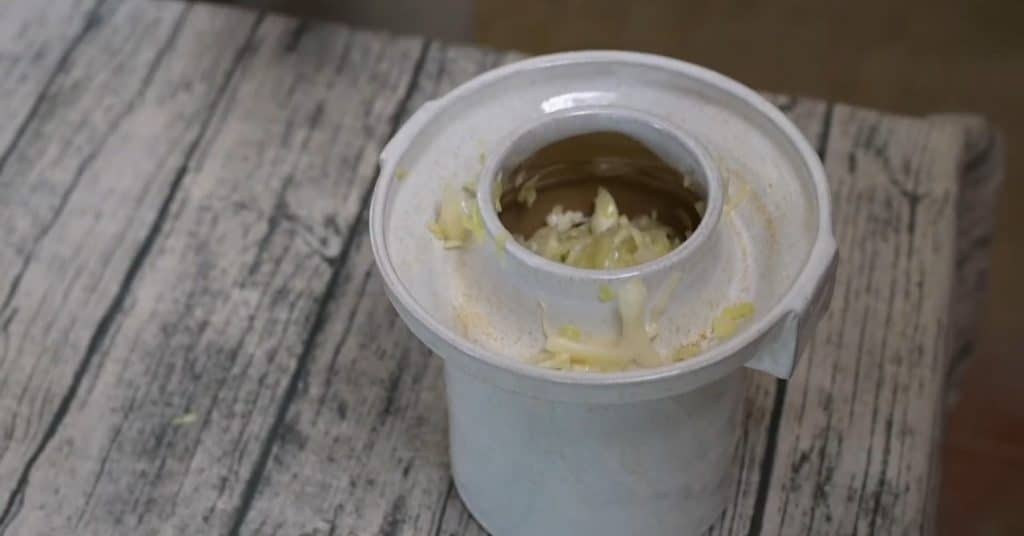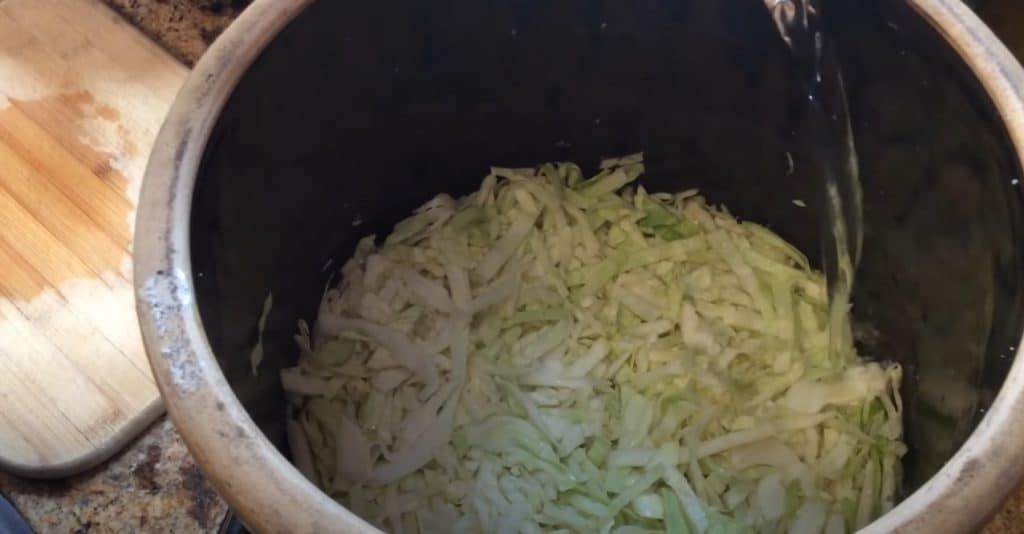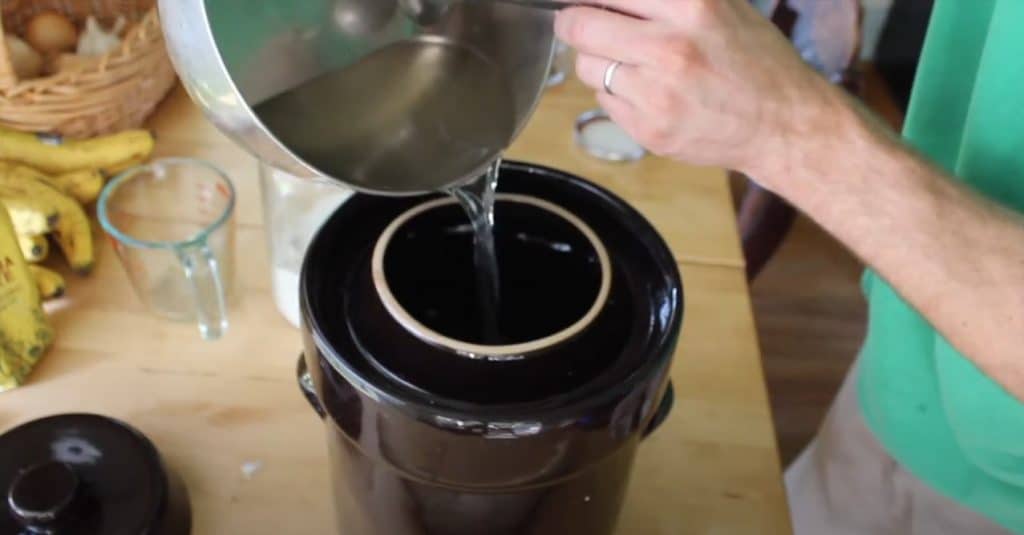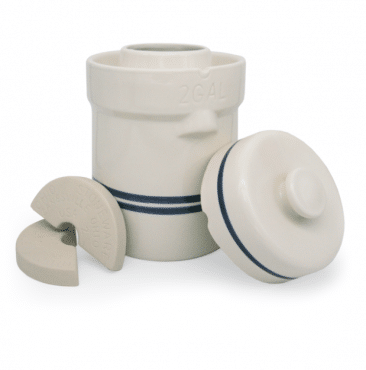Fermenting food is one of the most ancient ways to preserve food and change its taste qualities. What is more, it is probably the easiest way to convert vegetable or fruit leftovers since it does not require long-lasting complicated techniques to proceed to the result. With this method, food crops will find their place in the culinary world and on your kitchen shelf, including not only pickles but also vinegar, kimchi, any kind of hot sauce, and numerous other foods.
Fortunately, there is no need to acquire many various kitchen utensils to launch your own homemade production. You will need only a few tools, including the fermentation crock itself, maybe several ceramic jars, and some amount of cutlery. However, the quality of the tools has to be on the top since it directly affects the character of the final product.
In this article, you will find all the necessary information about how to use fermentation crock, how to choose it and for which purposes, and what are the possible benefits and shortcomings of its usage.
Why Should I Consider Using Fermentation Crocks?

In any way, we are here to suggest to you all the possible help so that you can decide for yourself whether you want to try this option or not. First of all, let’s see what you can do with fermenting crocks:
- sauerkraut
- dilly beans
- pickles
- vinegar
- kimchi
- fermented ketchup or mayonnaise, etc.
Surely, you can always buy all this stuff in the nearest shop. However, it is known that homemade food is always more reliable and also fun to make. You can make sure the used products are natural and ready to eat and stop the fermentation process whenever you’d like to, which helps you to control the whole list of ingredients, including nutrition facts.

Talking about the components, there are many things bringing advantages to your health in fermented products. First of all, eating sauerkraut (fermented cabbage), for example, helps your organism to digest complex substances by breaking down plant cells. Moreover, it prevents the risk of cancer occurrence by providing enough amount of K2 vitamins and antioxidants.
Furthermore, fermented food includes gut bacteria which increases gut health. The lactic acid produced during the fermentation process pre-digests the food before it gets into the stomach, so your guts have to work less.
What is also interesting, fermenting foods are famous for their depression-preventing qualities. While fermenting, antidepressants are form in the prepared foods. While eating whole vegetables freshly provides you with common forms of vitamins and cellulose, whilst fermented ones bring you more folic acid, peroxide, biotin, and riboflavin.
Another notable perk is that fermentation requires no sodium or sugar to preserve foods. It means that you will acquire fewer junk components while eating. Also, this method of preservation is the cheapest among many others as it needs only mason jars.
How Does Fermentation Works?

So, the whole process is based on tight plugging which does not let the air into the crock. By these means, the ferment submerged in the food gives growth to the bacteria which changes the taste and other qualities of the product.

There exist two types of fermentation crocks, which give different results and are also used in different ways:
- The open crock is representative of the most classic and traditional style of fermentation crocks. It is simply a large ceramic or mason jar that you fill with the chosen product and then close it with the ceramic weights. The main thing here is to prevent the air from invading the fermenting food, so you should close the top of an open crock with a lid or dense cloth. The final step is just to wait. As you can see, it is surprisingly easy to use open crocks to prepare fermented foods.
- Water-sealed fermentation crock is a more complicated yet way more reliable tool for fermentation. It has a special lid that perfectly fits the top of the crock and does not let the air enter the fermentation process. The lid sits tightly thanks to a lip that creates the water seal. However, carbon dioxide still may escape the airtight seal created inside the water-sealed crock.
The main difference between these two types is that water-sealed crocks may be harder to find but are easier to use and require less worrying from you after they are sealed as they come with particular lids and weights. However, you should constantly check the quality of the seal and refill the water from time to time. In contrast, open crocks are likely to be found more frequently even at grandma’s house since our grandmothers were using the same older crocks. But open crocks are harder to be used as you should find the fitting lid and weights.
So, the decision to purchase this or that crock can be affected by the chance of finding the needed tools. Luckily, the US is provided with fermentation crocks by the Ohio Stoneware company.
How to Choose a Perfect Fermentation Crock
There are several things you need to remember when choosing a fermenting crock, starting from the type and finishing by the shape and material. Every aspect of the final product may vary slightly according to the exactly chosen crock.
First of all, you should consider the size of your production. If you are not sure you will proceed with fermenting after the first try, you should not spend loads on a home fermenting factory and better think of one small crock. However, if you already got into this hobby and prepared your storage space for the process, you may purchase a big-size crock with heavier weights of better quality.
Another thing to pay attention to is the volume and mobility of the crock. Most likely, you will need to move the crock from one place to another when refilling it. Also, do not forget about the additional weights and lids. Therefore, determine your abilities in advance and do not acquire gigantic crocks if you will not be able to replace them. Another bad outcome is that the kitchen counter may break under the weight of full ceramic crocks, so make sure it is able to hold the whole fermentation crock with food inside.
Moreover, small batches are less likely to spoil the whole lot and will make a bigger amount of fermented food safe.
What you also should consider is whether to use the lid and ceramic weights or not. The good thing about them is that they prevent fruit flies and mold from the outside air from entering the product. Water-sealed crocks are especially good at these purposes yet you can succeed with it using open crocks too.
In general, the easier the crock to use, the more is the probability that you will use it often. If the crock is able to keep the food safe, it is already good, however, it also should be able to make the process comfortable, so you will want to produce larger batches and spend more time with this hobby.
How to Use Fermentation Crocks

Since now you know many things about Here are the inevitable steps that you should do when you are ready to make your first try in using a fermentation crock:
- Before you put the vegetables inside, clean the crock with hot soapy water to kill all the bacteria which prevent the crock from creating optimal conditions for fermentation.
- Home fermentation only requires salt, water, crock, and vegetables. Therefore, after you wash your crock, you can proceed to put the whole onions, cabbages, carrots, or other vegetables into the crock.
- Use 3 tablespoons of salt for every 5 pounds of fresh produce. Stop filling the crock when 4/5 of the crock is full. You can use mason jars to ferment the leftovers. Fill the crock with water so that the water seal can be created.
- Make sure to seal the crock properly as the main idea of fermentation is not to let carbon dioxide into the production. You can use water-sealed crocks with included lids and glass weights or open crocks with a stone, plate, and dense cloth (however, it may result in Kahm yeast or surface mold occurrence, which is actually harmless yeast, yet are unpleasant to appear in the production).
- Leave the fermenting crock for 4-8 weeks untouched. If the temperatures are cooler, more time will be needed. Therefore, if it is hot outside, the fermentation is expected to happen very fast, so it is not likely to make fermentation in summer.
- Do not leave the fermenting crock tight on the floor. Rather lift it with wooden planks so that the condensation will not harm the covering as the bottom of the crock is usually not glazed.
- After the fermentation is finished, move the production to lead-free jars and store them in your fridge. Wash the crock properly and leave the stones in the open-air environment until they are completely dry to prevent the occurrence of mold.
As Lacto fermentation requires nothing except salt for launching the needed bacteria doing their work, so for making sauerkraut or pickles, you will only need to put the vegetables into the crock, salt them and fill them with a little amount of water. In the next couple of days, you have to check the crock and refill it or mend the weights if they are likely to let the air in.
Basically, the bacteria will do all the needed things by themselves, but you still have to pay attention to the process as if there is no lack of oxygen inside the fermenting crock, the final product has a risk to be off-taste or spoiled.
Our Top Choice

Surely, it is great if you find an old open crock in your house and try it for your first fermentation. If you do not succeed, you have two options – to leave this hobby or to dare yourself and buy a new water-sealed crock and get into it.
However, if you do not have any crock but strive to start fermenting, here are our top picks from what you can find online or offline in US shops.
Ohio Stoneware Small Bristol Open Crock
Ohio Stoneware pot is what you will find in the first positions of every rating. Ohio Stoneware is one of the oldest companies providing American households with fermentation crocks. They produce many crocks variations, one of which is a 2-gallon open crock. It has many advantages, especially for those who have little experience in fermenting foods. You can find a lid for it in shops or use a plate and cloth for an old-styled fermentation. It has a food-safe glaze and is of microwave and dishwasher-safe use.
Ohio Stoneware is also popular for its cozy designs and durability, so you may be sure that once you acquired one crock, you will use it for many years if you do not purchase several more.
Ohio Stoneware Fermentation Crock Kit

This Ohio Stoneware kit is great for beginners as it includes all the needed tools for water-sealed fermentation. Again, it is made with safe cadmium-free glaze and is stable to temperature shifts. Moreover, it comes in a set with two half-circle weights which will prevent you from using cloths and stones, which are sometimes hard to control.
Although the price seems to be high enough, you will definitely enjoy using this kit. Moreover, the shipping costs are justified due to the delivery speed and quality.
Boleslawiec Polish Fermenting Crock

Moreover, each Boleslawiec fermentation crock comes with two luna glass crock weights which are great for water-sealed fermentation. Unlike Ohio Stoneware weights, these are not able to absorb odors and bacteria from fermentation, thus, no mold can occur there.
Crazy Korean Fermentation Containers
As we know, Koreans are great fans of fermented foods like kimchi or asparagus, therefore, we can rely on their traditions of fermenting. Fermentation containers are made with BPA-free plastic and will not spoil the production. At the same time, they are easy to carry and have very useful handles, unlike a stoneware pot, for instance.
All in all, our permanent leader of the rating is Ohio stoneware fermentation crock as it provides customers with all the necessary фтв сщтмутшуте qualities of a fermentation crock. However, since it is not the cheapest choice, you may try the more budget positions firstly.
Pros and Cons of Using Fermentation Crocks

Pros:
- the straight walls make it easy to clean the crock afterward, unlike the curvy shapes of mason jars
- crocks are perfect for home fermentation, especially making sauerkraut or pickles as almost no effort is required and the capacity is enough for whole vegetables
- using a water-sealed crock will keep the fermentation odors inside the crock and will not let the mold, yeasts, or other outer organisms to the production
- clay walls keep the temperature inside the crock stable and thus provide comfortable conditions for the needed bacteria to appear
- there is a little chance that the brine will go out of the crock, which means that the final product will be more tasty and salty
Cons:
- clay weights and walls are likely to absorb odors and thus need more time to dry and recover after fermenting
- it is not convenient to produce large quantities of production since using many little crocks will cost a fortune and using one large crock is hard to move due to the weight of the crock itself and the absence of proper handles
- for using open crocks, you will need to find a fitting lid or use a plate, cloth, and stone for making a proper water seal
- water-sealed crocks are needed to be monitored constantly and refilled if needed, otherwise, the air can enter the seal and spoil the process
- ceramic crocks are difficult to control as you cannot see the inside and monitor the condition of the product
Conclusion

Moreover, you can also decide whether to use an open or water-sealed crock. Basically, you can even use a food-grade plastic bucket for your first try just to make sure you know how to use a water seal.
Frequently Asked Questions – FAQ
How Do You Ferment Without a Crock?
If you are not ready to acquire a crock, you can proceed to mason jars or even food containers. Surely, it is better to use reliable tools that will not spoil your food with harmful bacteria. So, you can use a mason jar to load it with vegetables, salt, water, and cover it with a dense cloth.
What Can I Use as Fermentation Weights?
Common fermentation weights are clay or glass blocks that maintain a friendly environment for the products and are heavy enough to control the quality of a water seal inside the crock. Therefore, you may use suitable ceramic weights or stones (wash them properly before using them).
How to Use a Fermenting Crock?
If you are using an open crock, just fill it with vegetables so that 1/5 of the crock is left empty, pour some water so that it covers all the vegetables, and add 3 tablespoons of salt per every 5 pounds of product. For a water-sealed crock, doo the same and create a water seal with the weights and lid.
When to Ferment in a Crock?
It is better to avoid fermenting in hot seasons as it may affect the process rapidly. Generally, in cooler temperatures, fermentation appears to go slower and in a more controlled way. Therefore, it is better to ferment in autumns and springs.
How to Care for Your Crock?
Before you start putting fresh produce in the crock, do not forget to wash it with hot soapy water to reduce the opportunity of harmful bacteria to join the process of fermentation. After the fermented foods are done, make sure you remove all the surface molds from the inside. It is better to leave the ceramic weights to dry in the open air.



